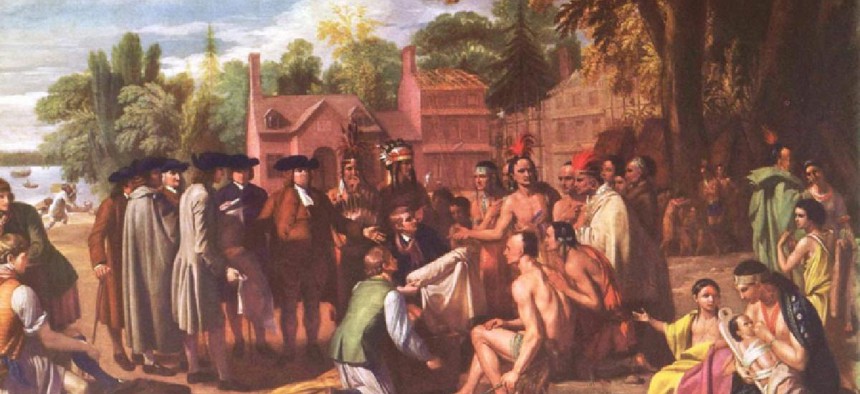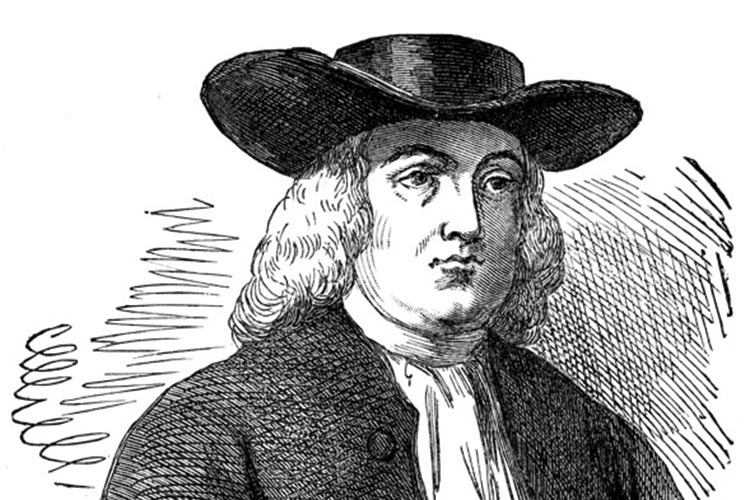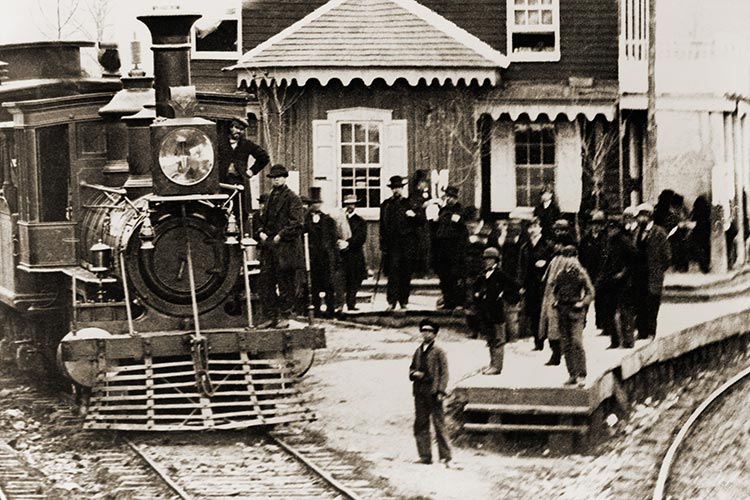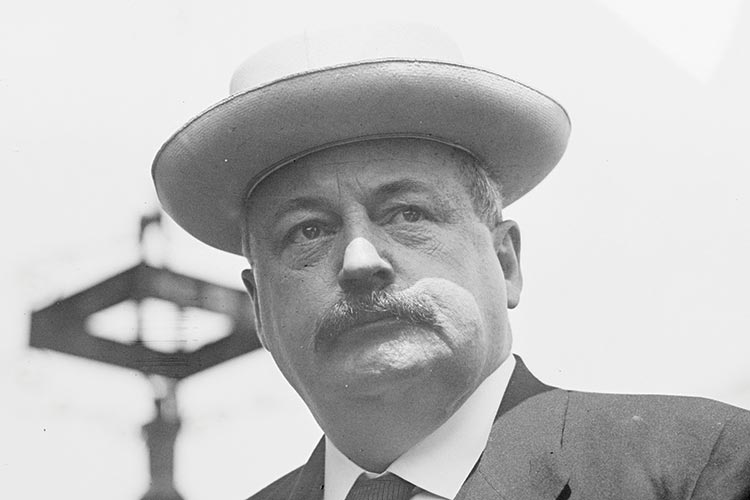Education
Political Influence in Pennsylvania

"The Treaty of Penn with the Indians" by Benjamin West Depicts a legendary 1683 peace agreement between William Penn and members of the Lenape Tribe on the Delaware River.
When Republican Tom Ridge tried to propose reform and referenda as a newly elected governor in 1994, the leaders of the GOP-controlled legislature informed him they would only consider the time-honored business agenda that Republicans have followed since the 19th century. Ridge gave them what they wanted and became a widely popular governor. Successful politicians know that past is always prologue in the Keystone State.
“Pennsylvania’s politics are complex because of the origins of its settlement and the diversity of its population,” said Terry Madonna, director of the Franklin & Marshall College Poll and the college’s Center for Politics and Public Affairs. “Through the development of late 19th and early 20th century industrialization and one-party-boss rule, it became a democratically competitive, two-party state that continues to play a leading role in American politics.”

The history of Pennsylvania – as well as the politics of the commonwealth – owes a debt to the British monarchy. The “Holy Experiment” began in 1680 when its 36-year-old founder, William Penn, was granted an extraordinarily generous charter by England’s King Charles II: 45,000 square miles of land.
The king’s charter made Penn the largest non-royal landowner in the world at the time – an action executed less out of generosity than necessity. The crown owed Penn’s late father, an admiral who proved a loyal and effective sailor, a significant amount of back pay (about $3.3 million in today’s dollars) and the king took the granted land from the Duke of York, leaving the duke with the colonial holdings of New York, the island of Manhattan and parts of Delaware.
King Charles also wanted to get Penn out of England, where the Quaker freedom fighter had been imprisoned for his defiance against the Church of England. With the newfound land, which he named Sylvania (Latin for “woods”), and which King Charles renamed Pennsylvania in honor of Admiral Penn, William Penn went about establishing what historians describe as a “political utopia.” His revolutionary “charter of liberties” guaranteed free and fair trials by jury, freedom of religion, freedom from unjust imprisonment and free elections. The king had no objection to such radical lawmaking in the colony, although he reserved the right to override any of the laws.
To make his Holy Experiment a profitable enterprise, Penn went about first attracting Quakers, many of them happy to leave their oppressors in England to buy property and live in Penn’s Woods. He later attracted other persecuted minorities throughout Europe, among them Amish, Catholics, Jews, Mennonites, Huguenots and Lutherans – the foundation for a diverse electorate that would form voting blocs and require adroit political skills for future statewide office seekers.
“Since representative government first began with the 54-member elected Provincial Council on March 12, 1863, the Pennsylvania citizenry has evolved into one of the most diversified in the nation,” journalist Paul Beers wrote in his definitive book on the subject, “Pennsylvania Politics: Today and Yesterday.”

Influenced by liberal philosopher John Locke, Penn organized a representative government with a General Assembly, although it lacked real powers, and established a public discourse in which all people were permitted to speak freely, similar to how Quaker Meetings are conducted.
Historians such as Hans Fantel, author of “William Penn: Apostle of Dissent,” and Bonamy Dobree, who authored “William Penn: Quaker and Pioneer," wrote that Penn established what would later become the basis of the U.S. Constitution: a flexible framework for governance that could be amended to reflect and adapt with the evolving times. “Governments, like clocks, go from the motion men give them,” Penn has been quoted as saying.
Since then, that motion has often been powered by ambition, greed and self-interest – as Penn’s offspring would demonstrate 57 years after he established Pennsylvania. His sons, John and Thomas, essentially swindled the indigenous Lenape Indians out of an area of land in eastern Pennsylvania that was roughly the size of Rhode Island. As late as 2004, the land deal was still being disputed in federal court by one of the Lenape tribes, Delaware Nation. A U.S. District Court dismissed the case, but acknowledged fraud was used to acquire the land, according to court records.
In 1722, a young Benjamin Franklin arrived in Philadelphia, a fugitive from his home state of Massachusetts for writing pamphlets criticizing the government in Boston while advocating for free speech. Twenty-nine years later, the newspaper publisher and author practically ran the City of Brotherly Love and had been elected to the Pennsylvania Assembly. By 1785 he was the second-most influential leader of the American independence movement, serving as a delegate at the Constitutional Convention in Philadelphia two years later.
“It is in Pennsylvania that the two characters (of Northern and Southern states) seem to meet and blend and to form a people free from the extremes both of vice and virtue.” – Thomas Jefferson
At the time, Philadelphia was the seat of the state government, but the U.S. Congress had also been meeting in Independence Hall during the nation’s early years, which compelled state legislators to find a new place to call home. They first went to Lancaster before eventually settling on Harrisburg in 1810, after John Harris, a trader and frontiersman, gave the state land along the Susquehanna River, where his father had started a trading post.
Since then, Harrisburg has been the seat of government and the headquarters of the Pennsylvania’s Democratic and Republican parties, but the state’s political power comes from its two largest cities, Philadelphia and Pittsburgh. Indeed, Harrisburg, often viewed as a backwater by some politicians, succeeded in stopping an early 20th century attempt by those same politicians to return the state capital to Philadelphia.
By the late 19th century, Pennsylvania’s political power emanated not only from its two largest cities, but also from those made wealthy through ventures like drilling, mining, smelting, timbering, forging, railroading and banking.
Well into the 20th century, the Pennsylvania Railroad, at one time the largest railroad in the world – employing a quarter of a million workers, tens of thousands of them in Pennsylvania alone – had such dominance in the legislature that its lobbyist had a desk on the floor of the statehouse, where he would review any bills that affected the railroad. “PRR officials were extraordinarily adroit at influencing the courts and, to an even greater degree, the legislature,” according to the multi-volume history, “The Pennsylvania Railroad, Vol. 1: Building an Empire, 1846-1917.”
Other industry giants in coal, steel and manufacturing wielded significant political influence, just not as dominantly as the PRR.
The Mellon family of Pittsburgh made its fortune in business, banking and publishing, with Andrew Mellon serving as U.S. Treasurer under three presidents in the 1920s and ’30s. The political influence of western Pennsylvania’s most powerful dynasties – the Mellons, steel magnates Andrew Carnegie, Charles Schwab and Henry Clay Frick, Sun Oil Co. (Sunoco) tycoon Joseph Pew, among others – was unstated, but, as Beers noted, politicians knew they risked their political livelihoods by not knowing and responding to their needs.
“The old joke about the Republican-controlled state Senate was: ‘The Pennsylvania Railroad having no more business in this chamber, we stand adjourned,’” Beers wrote. “And pamphleteer Henry Demarest Lloyd in 1881 penned the oft-repeated line: ‘The Standard (Oil) has done everything in the Legislature of Pennsylvania except to refine it.’”
While Pennsylvania produced a couple of Founding Fathers and was the birthplace of the U.S. Constitution, it has given the country exactly one president, James Buchanan, who failed to address the issue of slavery that resulted in the secession of the southern states, leaving his successor, Abraham Lincoln, with a nation divided.

The state’s most capable politicians have served as governors and U.S. Senators. Before Lincoln named him Secretary of War, Simon Cameron, an opponent of slavery, served in the Senate. He was nominated for president at the 1860 Republican National Convention, but he supported Lincoln in a deal that included the Cabinet post. Cameron returned to the Senate after the Civil War (he arranged to have his son, Donald, serve as President Ulysses S. Grant’s Secretary of War and then inherit his Senate seat) and headed Pennsylvania’s GOP.
Lawyer Matthew Quay would replace Cameron as party boss, serving as GOP chairman from 1878 until 1902, doing double duty during much of that time as a U.S. Senator. “Quay was the ultimate schemer and spoilsman in Pennsylvania politics,” Beers wrote. “He originated the phrase ‘shaking the plum tree’ to explain his method of using political pressure to extract money from clients.”
According to Beers, New York boss Tom Platt cited Quay as “the ablest politician this country has ever produced.” At Quay’s death, U.S. Sen. Boies Penrose, already a power broker, became the dominant political player in the state. “The Quay-Penrose machine had long tentacles, touching the White House, the Congress, the Governor’s Office, and the legislature down through the courts and local, county, municipal and school board jurisdictions,” Beers wrote. At Penrose’s death in 1921, Gov. William C. Sproul eulogized, “We shall not see his like again.”
Pennsylvania continues to have its share of political rogues and rascals, but it also has had reformers, such as Gov. Gifford Pinchot, the first chief of the U.S. Forest Service, who in the 1930s improved farmers’ livelihoods with paved farm-to-market roads, expanded the parks and improved conditions for coal and iron workers.
Democrats began to dominate Pennsylvania politics in 1934, when Pittsburgh business executive Joe Guffey unseated a Republican to become the first Democrat in 60 years to win a U.S. Senate seat in the state, while wealthy businessman George Earle from Philadelphia’s Main Line became the first Democrat in the 20th century to win the governorship. Others would follow, such as governor and four-term Democratic mayor of Pittsburgh David Lawrence, who was known to have had a strong influence in securing the party’s presidential nomination for Franklin D. Roosevelt and John F. Kennedy. In 1971, Milton Shapp became Pennsylvania’s first Jewish governor as well as the first to serve two terms after the state constitution was amended to allow governors to succeed themselves.
“Pennsylvania started to become a competitive two-party state with Roosevelt’s election in 1932 as well as the success the Democrats had with the New Deal,” said Madonna, who wrote the 2008 book “Pivotal Pennsylvania: Presidential Politics from FDR to the Twenty-First Century.”
The 21st century dawned with Republican Gov. Tom Ridge resigning midway through his second term to serve in the Bush Administration, becoming the nation’s first Secretary of Homeland Security in 2003. He was succeeded by lieutenant governor Mark Schweiker, who chose not to run for the office when Ridge’s term expired.
Former Philadelphia Mayor Ed Rendell, a Democrat, followed Schweiker into the governor’s office, and the political influence he wielded in his two terms often frustrated Republicans and Democrats alike. Together with Congressman Robert Brady, who is also Philadelphia’s longtime Democratic boss, Rendell has become one of the commonwealth’s most high-profile power brokers. Two of his former Cabinet secretaries, Katie McGinty and Tom Wolf, who headed the departments of environmental protection and revenue, respectively, have benefitted from his endorsements – McGinty just won a hotly contested Democratic primary for the U.S. Senate and Wolf is now governor of Pennsylvania.
Much has changed in the 336 years since William Penn began his experiment in the rural woodlands of Pennsylvania, but the primacy of political power has remained unchanged. To paraphrase American historian Henry Adams, the state is like a coalbed: dark and dirty, but a source of light.
